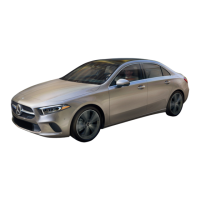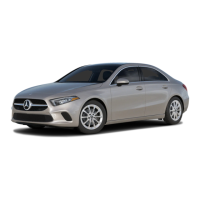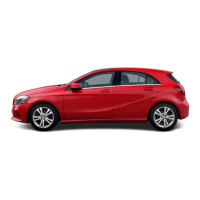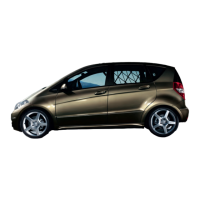R
independently of the front airbags
R
independently of the belt tensioners
Windowbags
The windowbags enhance the level of protec-
tion for the head (but not chest or arms) of
the vehicle occupants on the side of the vehi-
cle on which the impactoccurs.
The windowbags are fitted into the side of the
roof frame and run:
R
from the front door (A-pillar) to the rear
door(C-pillar) on 5-door vehicles
R
from the front door (A-pillar) to the rear
sidewall (C-pillar) on 3-door vehicles
If your vehicle is fitted with windowbags, the
frontseats of the vehicle will be equipped
with sidebags instead of head/thorax side-
bags.
Windowbags : are deployed:
R
on the side on which an impact occurs
R
at the start of an accident with a high rate
of lateral vehicle deceleration or accelera-
tion, e.g. in a side impact
R
regardless of whether the front-passenger
seat is occupied
R
independently of the frontairbags
Active head restraints
The active head restraints increase protec-
tion to the driver's and front-passenger's
head and neck. In the eventofarear-end col-
lision the force exerted by the driver's or
front-passenger's chest causes the head
restraints on the driver's and front-passenger
seats to be moved forwards. This provides
better head support.
G
Risk of injury
Do not secure any objects (e.g. coat hangers)
on the head restraint rods. Otherwise, the
active head restraints may not function cor-
rectly and could fail to provide the intended
protection in the event of an accident.
Seat belts
Important safety notes
Seat belts are the most effective means of
restraining the movement of vehicle occu-
pants in the event of an accident. This
reduces the risk of vehicle occupants coming
into contact with parts of the vehicle interior.
G
Risk of injury
A seat belt which is not worn correctly, or
which has not been engaged in the seat belt
buckle correctly, cannot perform its intended
protective function. Under certain circum-
stances, this could cause severe or even fatal
injuries in the event of an accident.
Make sure that all occupants –inparticular,
pregnant women – wear their seat belt cor-
rectly at all times.
R
The seat belt must fit snugly on your body
and must notbe twisted. Therefore, avoid
wearing bulky clothing, e.g. a winter coat.
The shoulder belt section must be routed
across the centre of your shoulder – on no
account across your neck or under your
arm –and pulled tight against your upper
body.The lap belt must always pass across
your lap as low down as possible, i.e. over
your hip joints –not across your abdomen.
If necessary, push down the belt strap
slightly and then retighten it in the roll-up
direction.
R
3-door vehicle: the swivelling belt guide
must be in the correct position.
Occupant safety
37
Safety
Z

